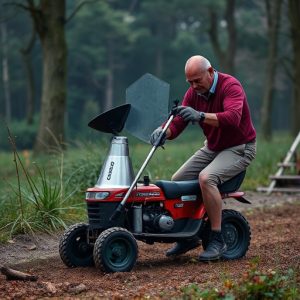Mastering Self-Defense with a Kubotan: Essential Techniques and Usage Tips
The Kubotan is a martial arts tool designed for self-defense, resembling a pen but capable of exten…….
The Kubotan is a martial arts tool designed for self-defense, resembling a pen but capable of extending a user's striking power through precise and controlled techniques. Its effectiveness lies in the specialized training required to use it safely, which includes learning to strike vulnerable points, perform strategic disarming maneuvers, and execute control tactics. The compact nature of the Kubotan allows for discreet carry, enhancing its utility as a self-defense aid. Mastery of the Kubotan involves integrating it into martial arts practice, with proper grip, stance, and technique being paramount to effective use. It's essential to understand how to use a Kubotan within the context of various defensive scenarios, including deploying it from concealed carry and using it against grabs or assaults. To ensure safe and legal application, individuals should seek guidance from instructors specializing in Kubotan training. How to use a Kubotan effectively involves a deep understanding of its mechanics, applications, and the correct force and accuracy required for effective self-defense.
When it comes to self-defense, being equipped with effective techniques is paramount. Among the array of defensive methods, the Kubotan stands out as a versatile tool for neutralizing threats quickly and effectively. This article delves into the art of Kubotan self-defense, guiding readers through mastering its use with actionable insights. From understanding its design and material importance to executing strategic strikes, we’ll explore how to use a Kubotan within your self-defense practice. Whether you’re new to martial arts or an experienced practitioner looking to expand your skill set, the techniques and best practices outlined here will bolster your personal safety. Join us as we examine the intricacies of the Kubotan and its role in a well-rounded self-defense strategy.
Understanding the Kubotan: A Versatile Tool for Self-Defense
The Kubotan is a versatile tool that has become an integral part of many self-defense systems, particularly within the discipline of Karate. This compact, pen-like device is designed to extend the range and power of one’s techniques when faced with an attacker. To effectively use a Kubotan, one must understand its potential applications beyond just a self-defense keychain. The tool can be employed in various ways, from pressure point strikes to disarming an opponent. It’s crucial to receive proper training to learn how to use a Kubotan correctly, as improper use can lead to unintended consequences. Training encompasses understanding the angles and force required to deliver effective strikes while minimizing injury to oneself or bystanders. The Kubotan’s small size allows it to be easily carried for personal protection, and its effectiveness is amplified through the knowledge of leveraging it against sensitive areas of an assailant’s body. Mastery of Kubotan techniques is not about brute force but rather about precision and control. Proper training includes practicing with the tool to become adept at integrating it into self-defense scenarios, ensuring one can respond effectively to a threat in real-world situations.
The Anatomy of a Kubotan: Design and Material Considerations
The Kubotan is a self-defense tool that has gained popularity due to its effectiveness in various martial arts, most notably in Kenpo. This compact, pen-like device is designed to enhance one’s self-defense capabilities by extending the range and impact of one’s techniques. Its anatomy is meticulously crafted to serve as both a training aid and a formidable self-defense weapon. The Kubotan typically features a short, sturdy body with a rounded tip, allowing for precise pressure application without causing unnecessary harm should the situation call for restraint rather than escalation. The length of the Kubotan is a critical factor; it’s sufficiently sized to create distance between an attacker and oneself while still being easily concealable.
When selecting a Kubotan, the material from which it is made is equally important. It must be durable enough to withstand force and stress during practice or actual self-defense encounters. Common materials include aluminum, brass, or hard plastic, each offering different weight distributions and grip textures that can affect technique execution and control. The surface of the Kubotan should provide an anti-slip grip, ensuring it stays firmly in hand under duress. Additionally, understanding how to use a Kubotan effectively involves knowing how to integrate it into various strikes, blocks, and control techniques within one’s martial arts repertoire. Proper training under the guidance of an experienced instructor is essential to master its use safely and effectively, ensuring that it becomes a reliable extension of one’s own striking power.
Key Points to Master in Kubotan Self-Defense Training
Mastery in Kubotan self-defense training involves understanding the key points that enable one to effectively use this versatile self-defense tool. The Kubotan is a short, dense stick with a cap on each end, designed for key defense techniques. To proficiently use a Kubotan, practitioners must first learn the proper grip and stance that allows for quick and precise movements. This includes holding the Kubotan like an extension of your hand, ensuring you can access both ends without obstruction. Practitioners should also familiarize themselves with the various strikes, such as palm heel smashes and thumb rakes, which can be executed with the Kubotan to incapacitate an attacker.
Furthermore, learning how to use a Kubotan extends beyond basic strikes. It involves integrating the tool into traditional martial arts techniques, adapting them to augment your defensive capabilities. A critical aspect of training is practicing disarming tactics, which can be crucial if an assailant attempts to take the Kubotan from you. Additionally, incorporating the Kubotan into joint locks and pressure point strikes can significantly enhance your self-defense repertoire. Training should also include escaping grabs and holds while using the Kubotan, as this scenario is common in real-world encounters. Advanced training may involve learning to use the Kubotan as a distraction or deterrent, understanding its weight and balance for maximum impact, and recognizing when it can be used effectively versus when empty-hand techniques might be more appropriate. Consistent practice and drilling are essential to master these skills and to respond confidently in self-defense situations with the Kubotan.
Strategic Strikes with the Kubotan: Techniques for Neutralizing Threats
The Kubotan is an innovative self-defense tool that enhances one’s striking capabilities, allowing for precise and strategic attacks in a variety of self-defense scenarios. To effectively use a Kubotan, it’s crucial to integrate it into your martial arts training, particularly styles like Karate or Aikido that incorporate the use of such extensions of one’s force. Understanding how to hold and manipulate the Kubotan is the first step; it should be gripped firmly between the forefinger and thumb, with the rest of the fingers wrapped around it for control. The key techniques involve striking with the Kubotan to neutralize threats effectively. For instance, one can deliver a sharp strike to an assailant’s nerves or pressure points, which are often more vulnerable than muscles. A well-placed Kubotan strike to sensitive areas like the eyes, nose, temple, or joints can deter an attacker, buying valuable time to escape or until help arrives. Practicing these strikes with precision and confidence is essential; it’s not just about the power behind the tool but also the accuracy of the application. When integrating the Kubotan into your self-defense arsenal, it’s important to train under the guidance of a qualified instructor who can demonstrate proper form and technique, ensuring safety while learning how to use a Kubotan effectively in a self-defense situation. Regular practice will help you become adept at using the Kubotan as an extension of your own striking power, allowing you to respond to threats with a combination of skill and control.
Integrating the Kubotan into Your Self-Defense Arsenal: Tips and Best Practices
The Kubotan is a versatile self-defense tool that can significantly enhance your personal safety arsenal. When integrating the Kubotan into your self-defense training, it’s crucial to understand its applications and master the techniques associated with its use. Proficiency with the Kubotan involves more than just carrying the device; it requires regular practice and familiarity with its potential as an extension of your own striking power. To effectively use a Kubotan, one must learn to combine its use with proper stances and strikes, ensuring that each movement is both precise and powerful. Practicing basic strikes—such as palm heel strikes, hammerfists, and spear-hand thrusts—with the Kubotan can help you develop muscle memory and improve your accuracy under pressure.
Additionally, it’s important to complement your training with scenarios that simulate real-life confrontations. This includes understanding how to deploy the Kubotan from a concealed carry position swiftly and effectively. Moreover, training should also cover the use of the Kubotan for defense against grabs or attacks, teaching you how to use it to control an assailant’s limbs or to deliver targeted strikes to vulnerable areas. Best practices for using a Kubotan involve continuous practice, maintaining situational awareness, and being aware of the legal implications of its use. Always ensure that your training is conducted responsibly and within the bounds of the law, and consider consulting with a certified self-defense instructor who specializes in Kubotan techniques to guide your practice and ensure you are using this tool safely and effectively for self-defense.


